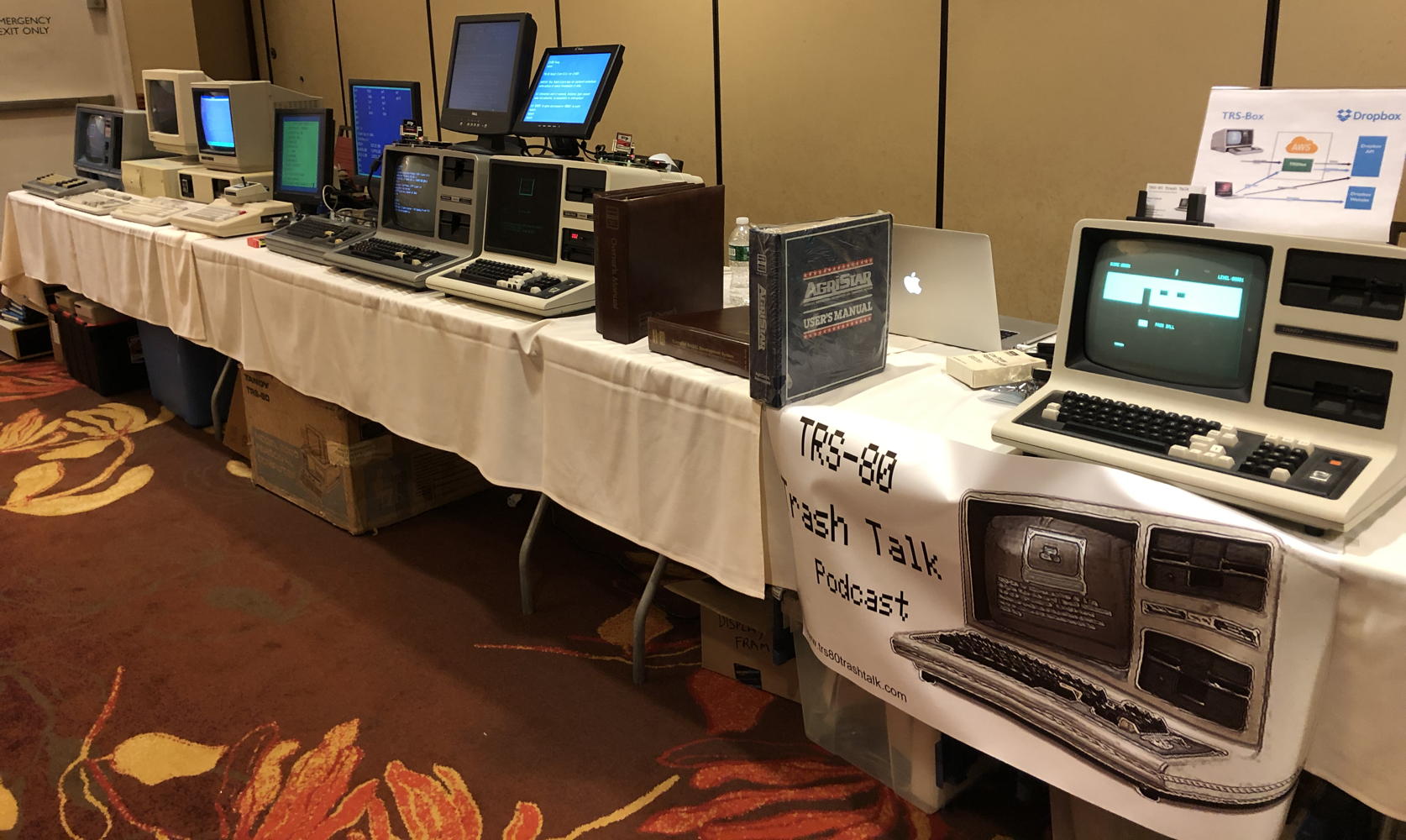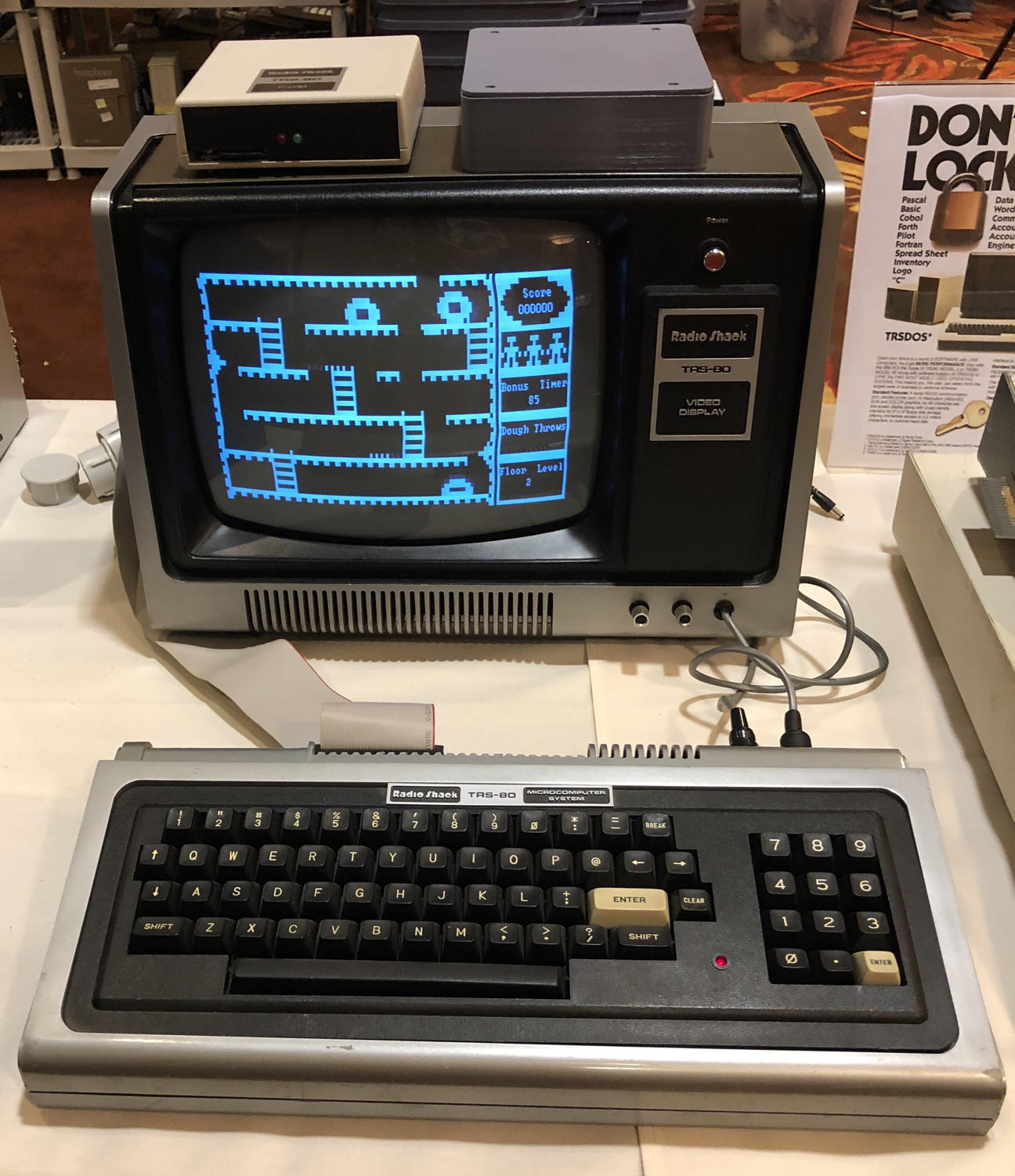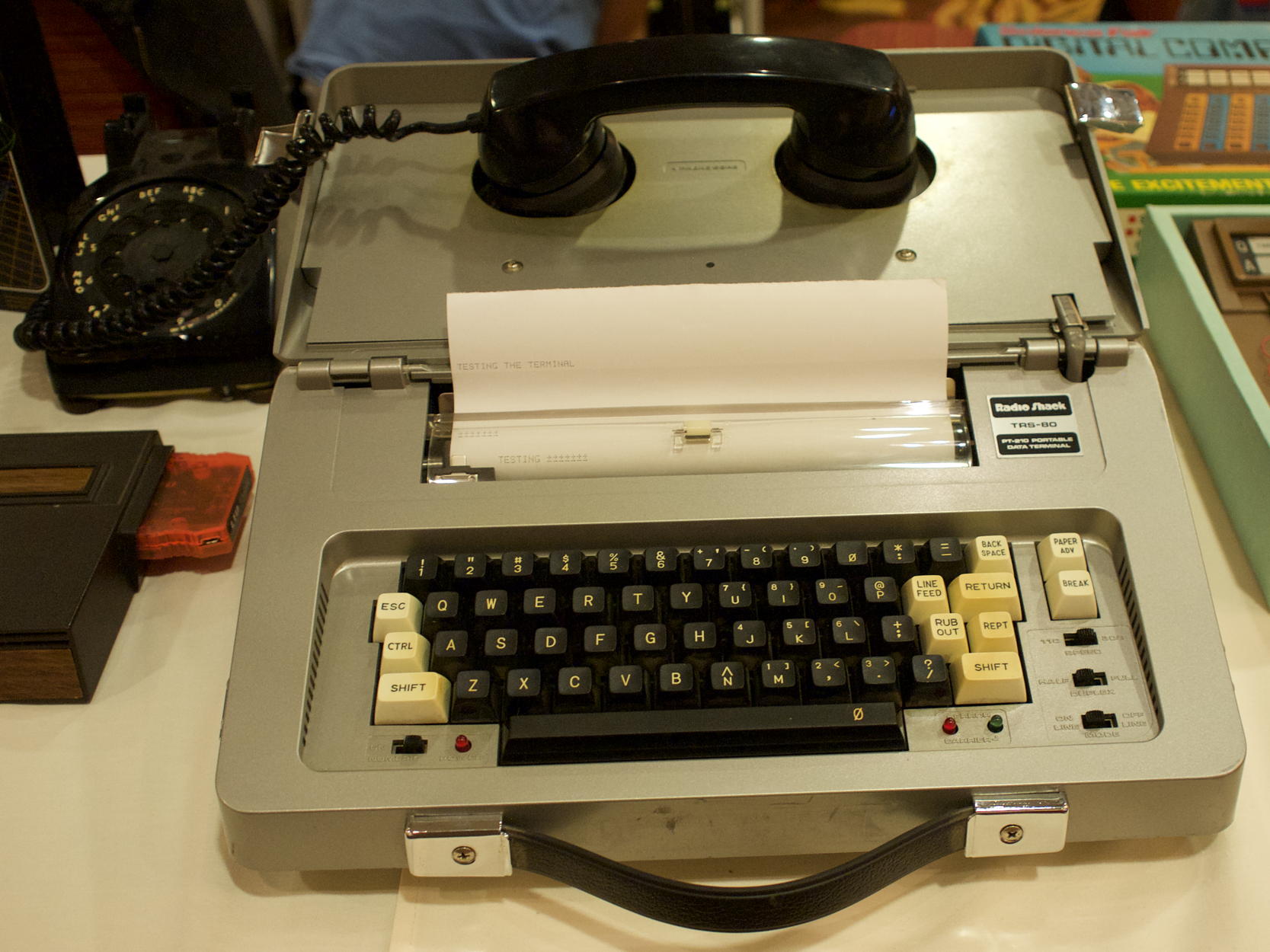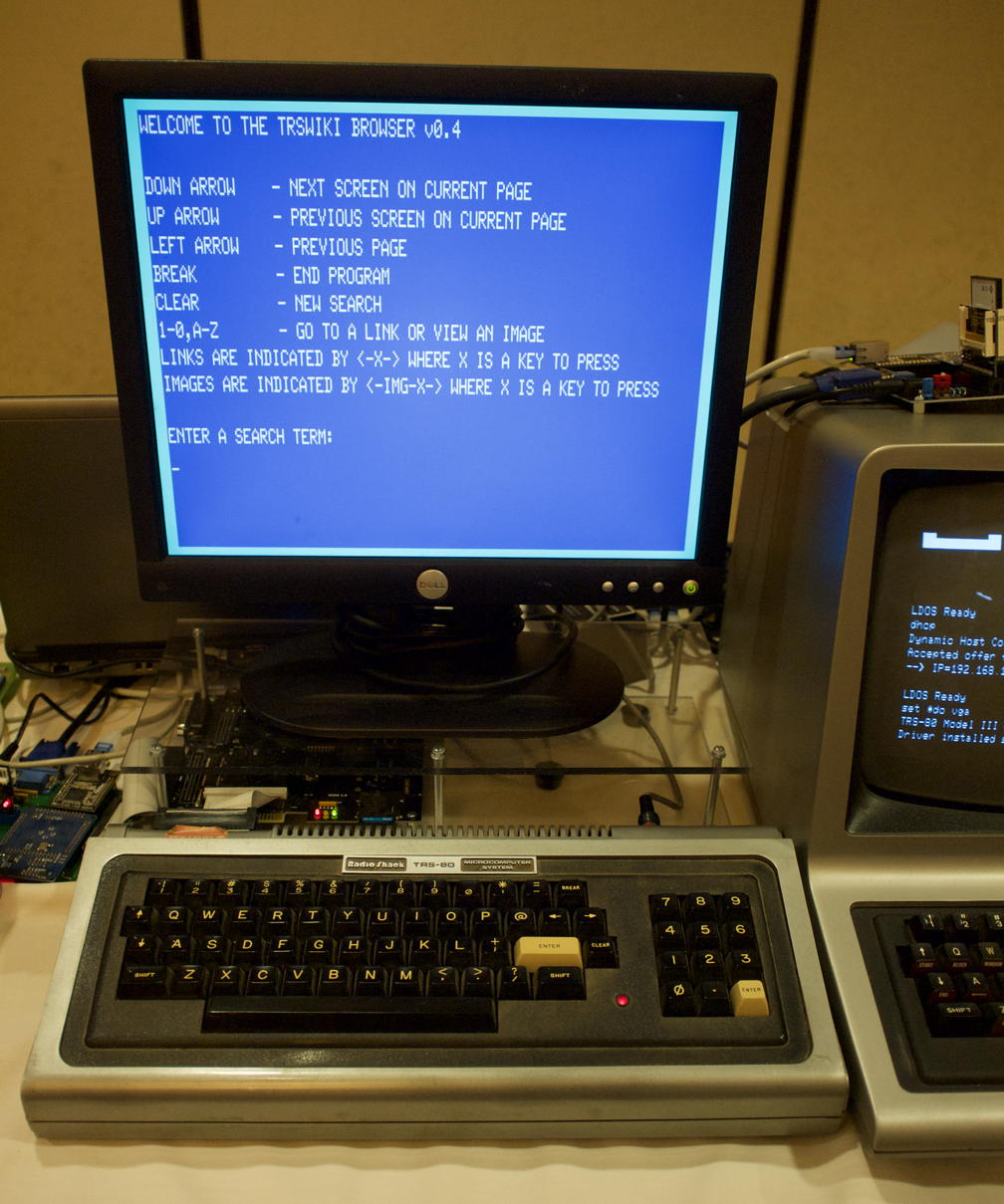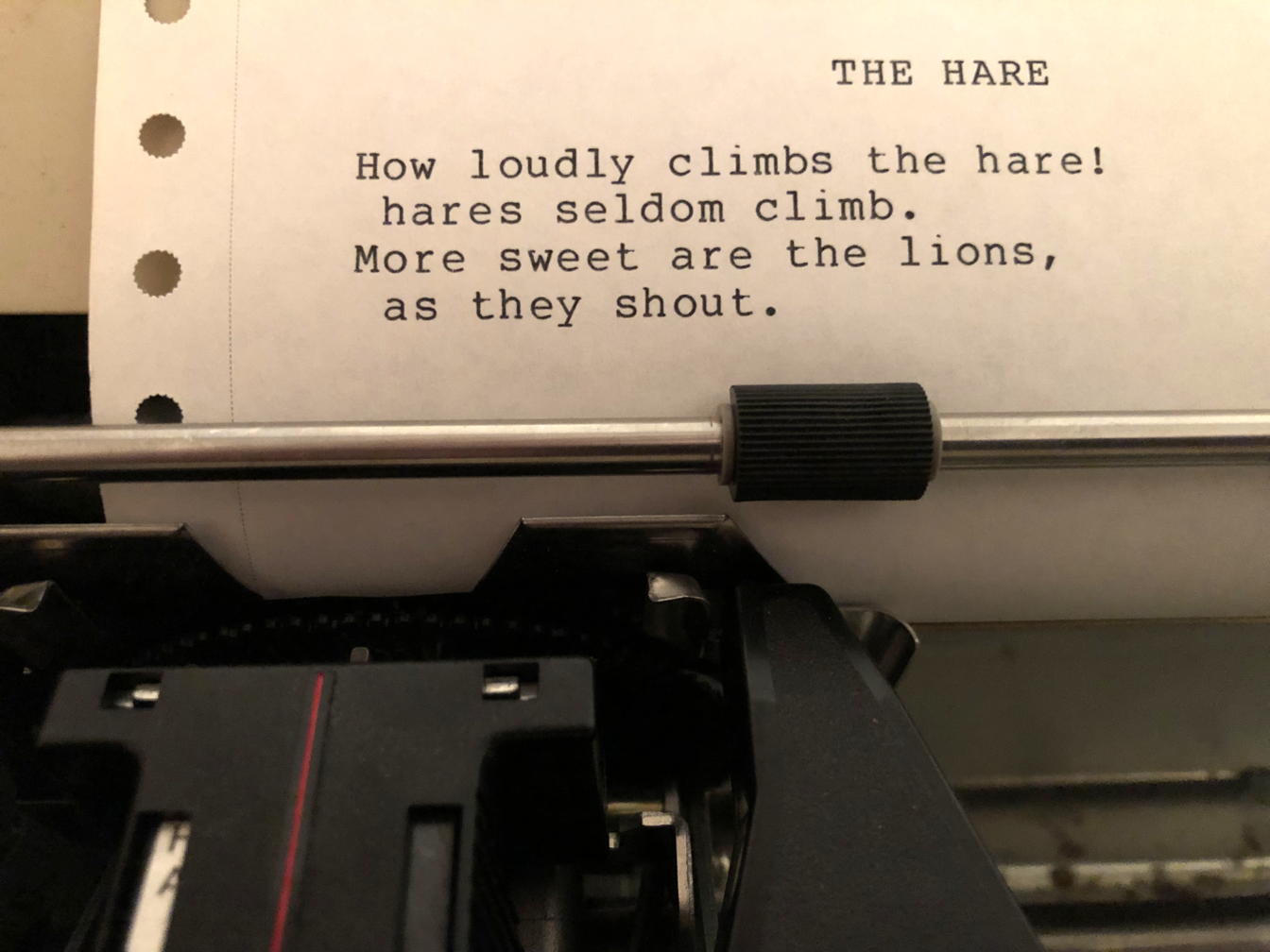Tandy Assembly 2018
I adjusted my Thanksgiving travel this year to take in Tandy Assembly in Springfield, Ohio. Tandy Assembly was started last year to mark the 40th anniversary of the introduction of the first complete computer, the Radio Shack TRS-80 Model I. Of course, it wasn’t called the Model I at the time. It was the “TRS-80 Micro Computer System”. It came with everything you needed to start using a computer. It even came with its own monitor!
The monitor was a clumsily-converted black-and-white television, but it still1 provided a relatively clear display compared to most of its competitors, which used RF modulators to convert the video output to radio signals for use in a television set.
This was well-known at the time, but it is more clear now just how clumsy the conversion was, due to the deterioration of the original monitors. The big “Radio Shack TRS-80 Video Display” badge on the right side of the monitor below the red power button was loose on one of the demonstration tables. Behind it are two empty round holes, where the VHF and, probably, volume knobs were.
And of course, “using a computer” meant programming it in BASIC, as the first computer, being both first and new, had no commercial software available for it.
The show was fascinating. I haven’t seen a working Model I since I sold mine for parts after a house fire in 1987.2 There were several on display here, running ancient games such as Donut Dilemma, Weerd, and Outhouse. It remains amazing just what programmers did back then in 384 by 192 pixels—managed through 128 by 48 blocks. Arthur A. Gleckler talked about writing Weerd in assembly language for the Model I and managing to get taken on by Big Five Software just before the bottom dropped out of the Model I games market.
Hit that link and you can play Weerd in a Javascript emulator.
There were also a lot of Model IIIs, Model 4s, and Color Computers there, as well as strange things I’ve never heard of. The TRS-80 PT-210 Portable Data Terminal looks amazing. It is exactly the kind of thing you’d expect to see in a movie like The Matrix. It’s about the size of an electric typewriter, with a handle, and looks like it could double as an electric typewriter in a pinch—although I doubt thermal printing was any more durable then than it is now. The amazing bit is the built-in acoustic coupler, allowing someone to use it anywhere with a then-standard phone. Including in a phone booth. And take a look at what’s missing. There is no screen, not even a tiny LCD. All input goes to the printer. Output might or might not, I expect people used the duplex switch to turn off printing of what they typed, to save thermal paper.
There was also a lot of kit-bashing going on. I saw a DNS server running on a Color Computer, a Wiki browser running on the Model I, and several more boxes for using flash memory for storage, using cloud for storage, and even building an app store for the Model I/III.
I picked up a daisy wheel printer, the Tandy DWP-230, at the auction. I am a big fan of daisy wheel printers, have been ever since I got one cheap from the old DAK catalog, my guess would be the Silver Reed EXP 400. Print quality was orders of magnitude better than the dot matrix printers of the era. It made a big difference submitting articles to magazines. It couldn’t do graphics—without destroying the print wheel3—but for a writer it was perfect.
I also picked up the December 1982 80 Micro and Jay Chidsey’s article on programming that included a random poetry generator in BASIC. The program was written for the Model I/III, but was easily modified for the Model 100 that I use today. Thus, the first use I put the printer to was printing random computer poetry from the early eighties.
I found David Lien’s The TRS-80 Model 100 Portable Computer, “a complete step-by-step learner’s manual” at the DigitalDinos booth. The first part is about the basics of using the Model 100’s built-in apps, but the second, longer part is about using the Model 100’s flavor of BASIC. The first computer book I read, as opposed to a computer magazine, was Lien's introduction to the TRS-80 Model I's Level I BASIC. It was extraordinarily readable while also being very useful, and was long the yardstick I used to judge other technical manuals. So of course I snapped this up. It shows how to use BASIC in general and how to use it for the special features of the Model 100, including its graphics and sound.
With Lien’s help—and DigitalDinos, who also had a cheap Centronics printer cable for the Model 100—I managed to turn a tiny Model 100 and a huge daisywheel printer into an electric typewriter complete with tabs and margin bell. I expect you’ll see that program here relatively soon, as well, if I manage it, a simplified Markdown printer for the Model 100, since Markdown is well-suited for the Model 100’s word processor. In the meantime, here’s how I printed the character set of the DWP-230:
- 10 U$ = "#####: !"
- 15 S = 56
- 20 FOR I = 32 TO 31+S
- 30 LPRINT USING U$;I;CHR$(I);I+S*1;CHR$(I+S*1);I+S*2;CHR$(I+S*2);I+S*3;CHR$(I+S*3)
- 50 NEXT I
Line 10 sets up the LPRINT USING string. It’s similar to the printf statement and its relations in other programming languages. Line 15 sets up the number of rows (the number of columns is hardcoded to three, typical for the BASIC programming of the era4). Line 20 steps through the possible ASCII character values starting with 32. ASCII character 32 is the space, and is the first printable character in ASCII. It prints a column for the Ith character, a column for i+56, a column for I+112, and a column for I+168. This makes the final character printed 255 31+S is 87; 87+56*3 is 255.
And LPRINT USING prints to the "line printer”, although few personal computers printed to actual line printers. And in this case I printed to a daisywheel printer, which is the quintessential character printer. It prints a character at a time by design rather than an entire line all at once.
If you’re a fan of those old computers, or interested in the history of the personal computer and you’re in the area, I think you’ll enjoy this show if they do it again next year. It’s fascinating looking at what we had to deal with then, and how we made these pioneering computers do really useful things.
And for your listening pleasure—for varying values of pleasure—the Model 100 playing twinkle, twinkle, little star. The numbers on the screen are the frequency and the duration, respectively.
Usually—quality could apparently be variable.
↑In fact, these things were tanks, and the computer still worked. But the plastic was all bent and melted due to the fire, and most of my disks were filled with mold from the combination of fire and the water used to put it out.
Even then, most of the disks still worked. The benefits of a very low information density.
↑In fact I did break at least one print wheel on it, probably less because of experimenting with graphics than because I often printed my massive tome of a superhero roleplaying game on it.
↑The real reason for it is that “56” is used several times in the PRINT USING line, where as 3 is used only once, following 1 and 2.
↑
- DigitalDinos
- “DigitalDinos is proud to be one of the many (?) places on the web where you can find classic computers and their software, hardware, manuals, and other stuff to expand your vintage computer collection.”
- RetroStore
- RetroStore uses an app store model for TRS-80 software, making it useful for both emulators and, through Internet boxes, the original computers.
- Tandy Assembly
- An apparently annual assembly—it started in 2017—of Radio Shack computer fans.
- Twinkle, Twinkle, Little Star on the TRS-80 Model 100: Jerry Stratton at Mimsy@YouTube
- “A BASIC program from David A. Lien’s The TRS-80 Model 100 Portable Computer shows how to use the Model 100’s sound output to play music.”
- Weerd: Arthur A. Gleckler
- “In 1982, Big Five Software published Weerd, a video game I had written for the Radio Shack TRS-80 microcomputer. In 2011, I was thrilled to discover the TRS-80 emulator written by Peter Phillips in JavaScript… Take a step back in time, and have fun!”
More 80 microcomputing
- Peer to peer email from 1980
- A fascinating vision of the convergence of e-mail and text messaging from 1980.
- The Radio Shack Postal Service
- What if Radio Shack had been granted a monopoly on computers in 1981? They’d probably look a lot like the United States Postal Service.
- The Future from 1981
- One of the hallmarks of good science fiction is not just envisioning future technologies, but also the effects of the technology on everyday life. In November, 1981, Wayne Green looked into the usefulness of the secretary in the age of the personal computer.
- 80-Micro and the TRS-80, 1983-1984
- I’m going through some old 80-Micro magazines, and two editorials a year apart caught my eye.
More computer history
- Creative Computing and BASIC Computer Games in public domain
- David Ahl, editor of Creative Computing and of various BASIC Computer Games books, has released these works into the public domain.
- Hobby Computer Handbook: From 1979 to 1981
- Hobby Computer Handbook lived for four issues, from 1979 to 1981. Back in 1979 and 1980, I bought the middle two issues. I’ve recently had the opportunity to buy and read the bookend issues.
- Hobby Computer Handbook
- Hobby Computer Handbook was a short-lived relic of the early home computer era, an annual (or so) publication of Elementary Electronics.
- 8 (bit) Days of Christmas: Day 11 (O Christmas Tree)
- Day 11 of the 8 (bit) days of Christmas is the graphic accompaniment to “O Tannenbaum” from Robert T. Rogers “Holly Jolly Holidays”, from December 1984.
- 8 (bit) Days of Christmas: Day 100 (Hearth)
- Lower resolution graphics were more appropriate for animation, because you could page through up to eight screens like a flip book. This is Eugene Vasconi’s Holiday Hearth from December 1986.
- Six more pages with the topic computer history, and other related pages
More TRS-80
- The Radio Shack Postal Service
- What if Radio Shack had been granted a monopoly on computers in 1981? They’d probably look a lot like the United States Postal Service.
- Radio Shack advertises the Color Computer vs. the Model III
- This Radio Shack ad, from the January 1981 creative computing is a good example of their strange ideas about what would sell.
- 80-Micro and the TRS-80, 1983-1984
- I’m going through some old 80-Micro magazines, and two editorials a year apart caught my eye.
- Baseball in the rain
- In 1980, after I bought a personal computer, I wrote a simple computer program in BASIC and sold it to one of the many magazines at the time. To the second-major newspaper of the area, this was a big deal.
- Priming the Pump: How TRS-80 Enthusiasts Helped Spark the PC Revolution
- David and Theresa Welsh wrote some of the first great software for the TRS-80, and knew a lot of the other people who were also writing great software. In Priming the Pump, they talk about the history of personal computers and the first non-kit mass-market personal computer, the TRS-80 Model I.
More video games
- Uriel, Angel of Fire drops you to 666 hit points
- I’ve been playing a lot of Angband lately. I’m now at the levels where I’m seeing a lot of angels, and they all want to kill me.

